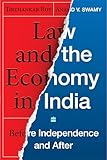Law and the economy in India : Before independence and after /
Publication details: Haryana HarperCollins Publication 2024Description: xxiv, 556 p. 24 cmISBN:- 9789362134066 (Paperback)
- 349.5409
| Item type | Current library | Shelving location | Call number | Materials specified | Status | Notes | Date due | Barcode | |
|---|---|---|---|---|---|---|---|---|---|
 BOOKs
BOOKs
|
National Law School | General Stacks | 349.5409 ROY (Browse shelf(Opens below)) | PB | Checked out | Recommended by Dr. Manpreet Singh Dhillon | 23.10.2025 | 39957 |
List of Illustrations;
Glossary;
Introduction to This Edition;
BOOK ONE:
LAW AND THE ECONOMY IN COLONIAL INDIA:
Timeline for Book One;
CHAPTER ONE: Introduction;
The Process of Legislation, 1772-1857;
Landed Property: Security and Incentives;
Landed Property and Credit;
Succession of Property: Joint versus Individual Right;
Labor Law: From "Slavery" to Trade Union;
Contract: Late Westernization;
Corporate Law: Flawed Westernization;
The Burden of Procedures;
Conclusion;
CHAPTER TWo CHAPTER HHREE CHAPTER FOUR CHAPTER FIVE CHAPTER SIX CHAPTER SEVEN CHAPTER EIGHT CHAPTER NINE CHAPTER TEN
BOOK TWO:
LAW AND THE ECONOMY IN A YOUNG DEMOCRACY:
Timeline for Book 2:
CHAPTER ONE: Introduction;
CHAPIER TWO: Land Rights: Equity versus Transferability?;
CHAPTER THREE: Rural Credit: Overreliance on Law;
CHAPTER FOUR: Democratic Rights and the Limits of Eminent Domain;
CHAPIER FIVE: Environmental Law: Judiciary Takes Center Stage;
CHAPIER SIX: Law in a Labor-Surplus Economy;
CHAPTER SEVEN: Politicians' Burden? The Evolution of Company Law;
CHAPIER EIGHT: Globalization with a Nationalist Face: Mergers Acquisitions, and Intellectual Property;
CHAPTER NINE: Property Equity versus Religious Norms;
CHAPTER TEN: Conclusion;
Acknowledgments;
Notes;
Bibliography;
Index.
Law matters for economic development, but where does it come from? And through what mechanisms does it affect different parts of the economy? In this insightful volume Tirthankar Roy and Anand V. Swamy start in the late eighteenth century, tracing the evolution of the British-Indian legal system as it emerged in the service of a cautious and self-serving colonial regime. They show that British-Indian law was designed to facilitate tax collection, permit international trade, and, above all, keep the regime in place. Since independence the Indian state has been much more confident and ambitious, seeking economic growth, equity, and poverty reduction. Therefore, it has also been far more interventionist, in policy and in law. Roy and Swamy have put together this entire two-hundred-fifty-year legal and economic history in a single narrative, for the first time, offering a unique perspective on the challenges of today.
There are no comments on this title.
